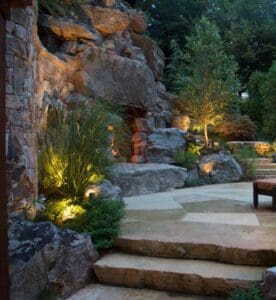 This article is meant to help you, the homeowner, better understand what questions to ask in the planning stage so you can work successfully with a landscape design professional to create the perfect setting for that outdoor fireplace you’ve been dreaming of.
This article is meant to help you, the homeowner, better understand what questions to ask in the planning stage so you can work successfully with a landscape design professional to create the perfect setting for that outdoor fireplace you’ve been dreaming of.
The first step in the process is to retain a landscape design firm and develop a comprehensive design plan for the site. If you are starting from scratch, this is a must. If you will be adding the fireplace to an existing landscape, it is even more important. Your landscape designer will guide you through exactly the right series of questions, decisions, and justifications for each step in the process.
Key Points to Consider When Planning an Outdoor Fireplace
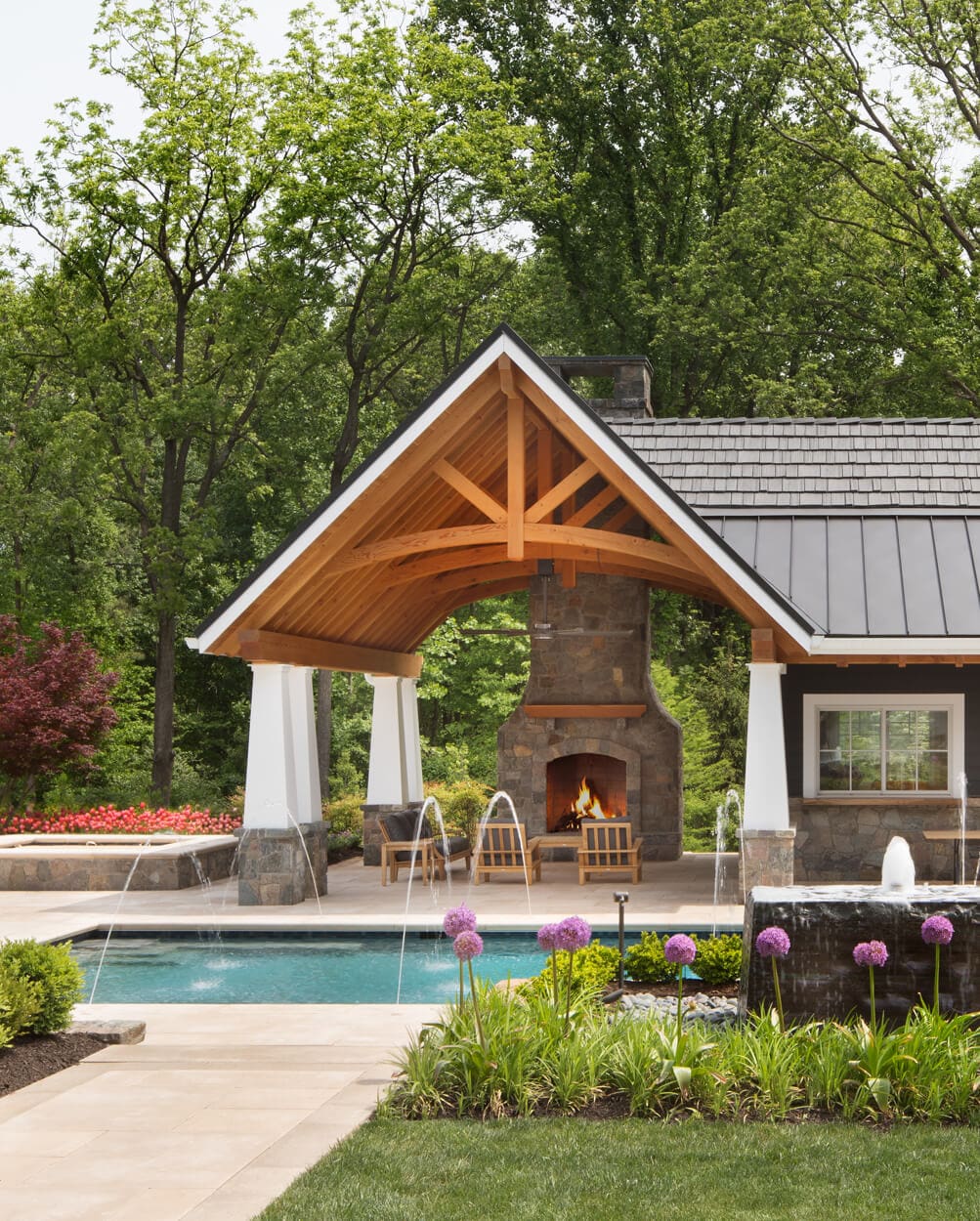 1 Location
1 Location
A few factors will determine the best location for your fireplace:
- Prevailing wind direction
- Proximity of trees and structures
- Relationship to other activity areas on the site (e.g., hot tub, swimming pool, dining patio)
Your landscape designer will note the effect of wind and nearby structures well before design begins. Then you’ll work out the relationships among the various outdoor rooms you will be creating. If you are adding your fireplace to a pre-existing outdoor environment, you may find it helpful to read this brief case study on siting and outdoor fireplace where the design had to overcome site limitations and difficult wind direction issues.
2 Size
An outdoor fireplace makes a big statement and automatically creates a focal point in the landscape. Factoring the distance from the house against the overall size of the backyard, the fireplace design will be scaled to fit comfortably in the available area. We want to be sure we don’t block desirable views or end up with a backyard that feels crowded by too many features that are too close together. In cases where we have limited yard space, there are small space options that can deliver a similar effect. We’ll get to those in a moment.
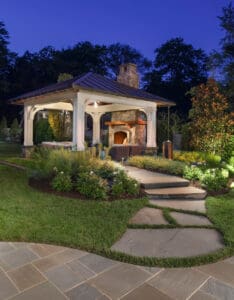 3 Purpose
3 Purpose
How do you imagine using your fireplace area and how will it relate to other activity areas in the landscaping layout? The fireplace could be the focal point for gatherings in an outdoor living room or dining room. Or it may bring cheery warmth to a lounging area following an evening soak in the spa.
4 Style
Do you want shelter from the elements or do you want to see the stars as you huddle by your backyard fireplace? Your outdoor fireplace could be:
- Built into a retaining wall
- A stand-alone patio installation visible on all sides
- The focal point for a shelter or screened porch
Construction Technique: Inside the Fireplace
Of course, your new outdoor fireplace will be magnificent to behold, but don’t forget that its main purpose is to generate heat. The way the fire chamber and flue is constructed will make all the difference. The best construction method we know of is the Rumford.
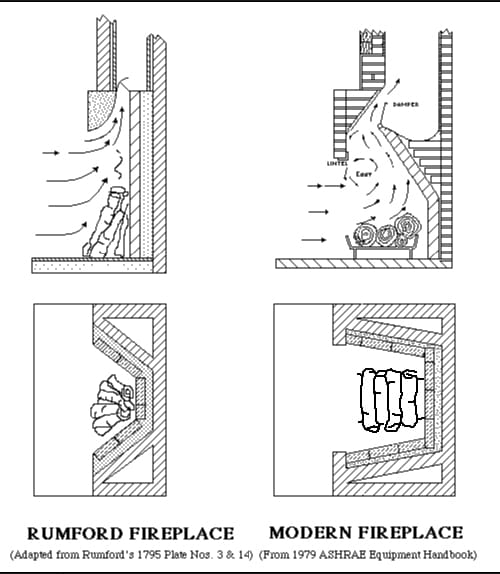 The Rumford firebox design was created in the late1700’s at a time when fireplaces were the only way for people to heat their homes. With the invention of modern heating systems, the fireplace took on a decorative role. Most of the heat that modern fireplaces produce shoots right up the chimney.
The Rumford firebox design was created in the late1700’s at a time when fireplaces were the only way for people to heat their homes. With the invention of modern heating systems, the fireplace took on a decorative role. Most of the heat that modern fireplaces produce shoots right up the chimney.
The Rumford fireplace features a tall, wide fire chamber. It is shallow with widely splayed side walls to project radiant heat out into the room. The back wall of the chamber goes straight up and meets a rounded edge that opens into the chimney. According to Jim Buckley of the Buckley Rumford Company, the internal shape increases “residency time” by about four times compared with the modern fireplace. Residency is the length of time that smoke is hot and in the fire. The result is that it burns cleaner, more efficiently and produces more radiant heat.
If you’d like to geek out on the technical aspects of the Rumford that make it different from and superior to the modern fireplace design, follow this link to an article by Jim Buckley and scroll down to the subheading Why Rumford Fireplaces Work.
Variations on a Theme: Fire Tables, Fire Pits, and Fireboxes
It’s important to talk with your landscape architect during the planning process to decide which version of the outdoor fireplace is going to work best with your overall landscape design plan.
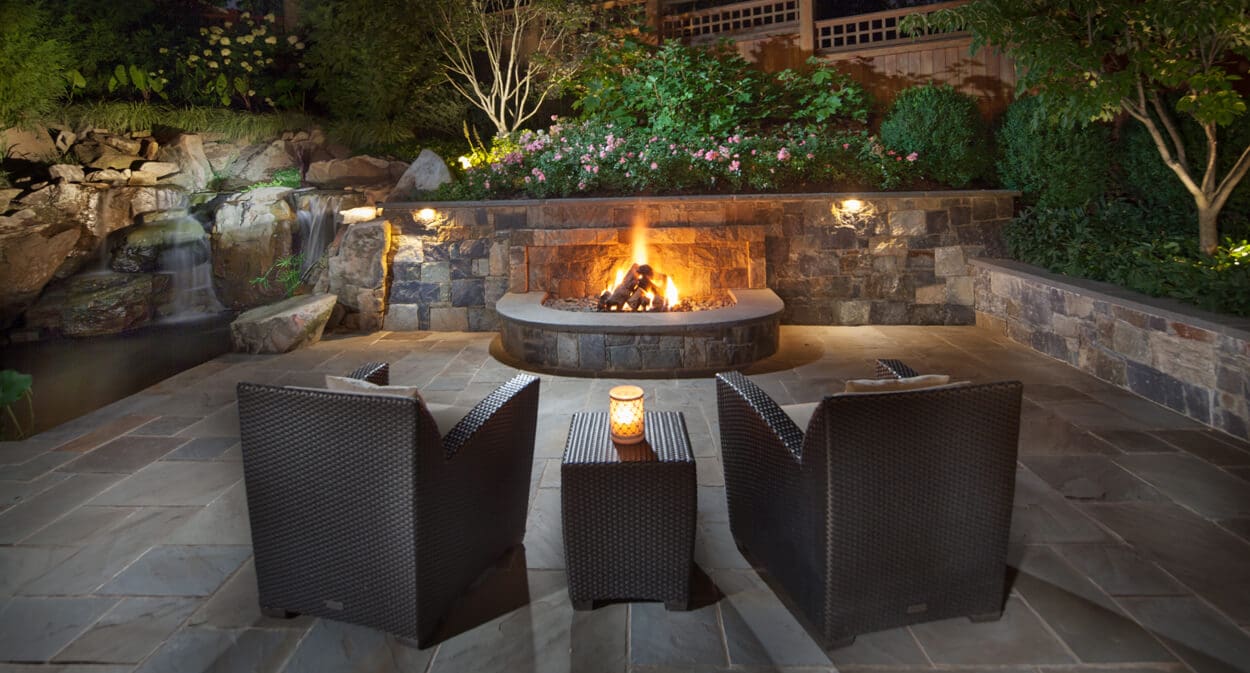
1 Fireboxes
Our latest outdoor fireplace installations have taken a new turn. The firebox is a hybrid that works perfectly for shallow yards or in landscape plans where the budget is focused on other features. A firebox is similar to a fireplace but minimalist and minus the chimney. It is built against a backdrop wall and works beautifully when snugged into a retaining wall with border plantings and the lot line beyond.
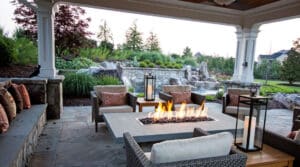
2 Fire Tables
These are gas-fueled installations. They can be permanent fixtures or may be purchased as modular units that can be moved around your patio or porch.
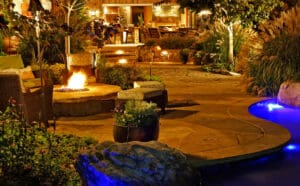 3 Fire Pits and Fire Rings
3 Fire Pits and Fire Rings
Simplicity and more simplicity. A fire pit typically takes the form of a raised enclosure with 360-degree seating around. Fire rings are usually at ground level and require a cleared space around and above just like a campfire area.
For pure simplicity and flexibility, a fire ring or fire pit is the way to go. You have more flexibility, as to where you site it in your yard because it is low to the ground, so doesn’t create a visual barrier. You can read about the difference between fireplaces and fire pits and their comparative benefits here.
Using Specialty Features to Define Outdoor Space
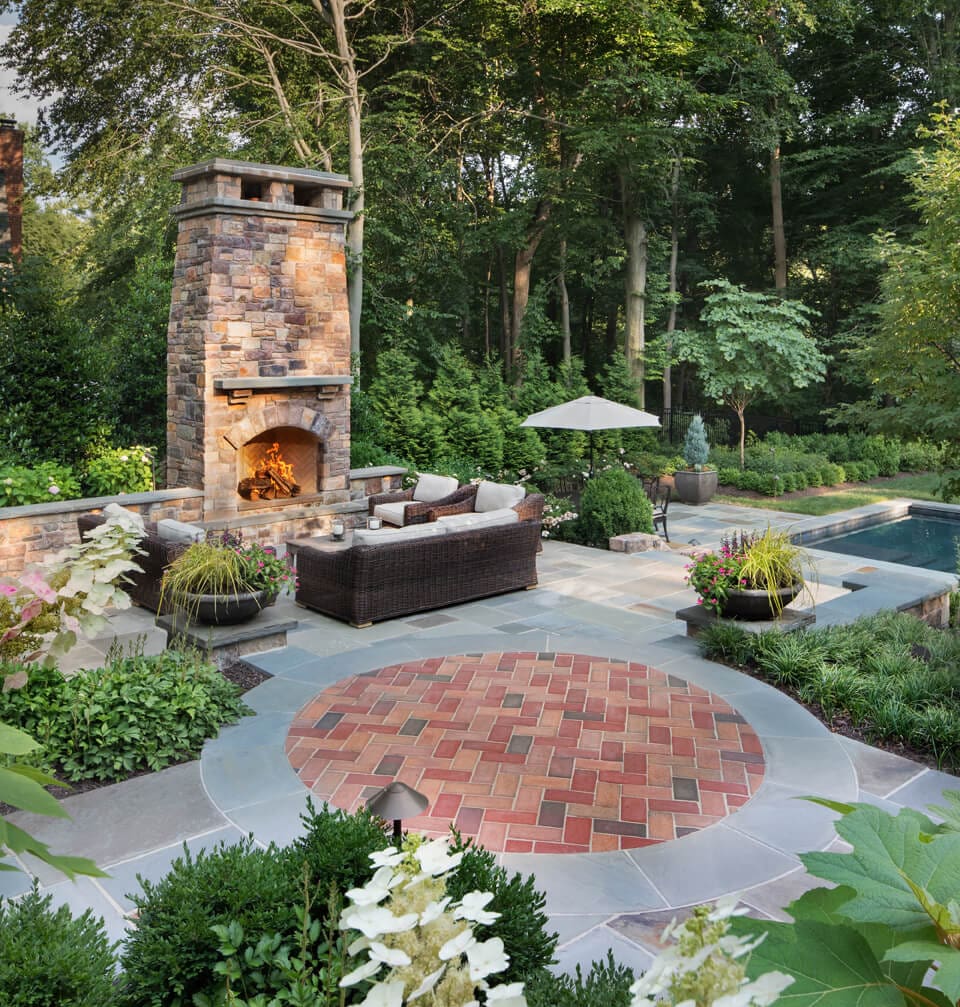 Specialty features like outdoor fireplaces contribute to the making of outdoor rooms. We define “rooms” by employing various design elements that divide your backyard into separate but related activity zones. Each room has a primary function and a defining visual anchor such as the fireplace, a fountain, waterfall or specimen plant.
Specialty features like outdoor fireplaces contribute to the making of outdoor rooms. We define “rooms” by employing various design elements that divide your backyard into separate but related activity zones. Each room has a primary function and a defining visual anchor such as the fireplace, a fountain, waterfall or specimen plant.
A studied combination of naturally occurring features, landscaping, and hardscaping completes the effect. Instead of walls, outdoor rooms are defined by changing elevations and surface materials, seating walls, plantings, borders—and of course, focal points such as your fireplace. Your outdoor room may use the open sky or an overhanging branch for a ceiling.
As you’ve surely realized by now, planning an outdoor fireplace for your backyard involves making a landscaping plan so that you can see where that fireplace fits into the whole picture. If you think of your outdoor fireplace as one key feature of an outdoor room with a specific purpose, you’ll end up with just the right fireplace for that extraordinary room that holds all the sights, sounds and fragrances of your garden within its “walls”.
If you like what you’ve seen in this article or want to know more about some of the featured fireplaces and fire pits, please contact one of our landscape architects. We love hearing about your landscape design ideas and much as we love building them.